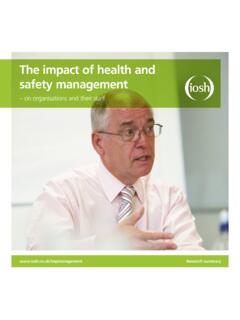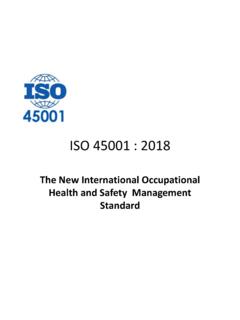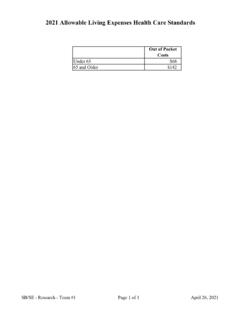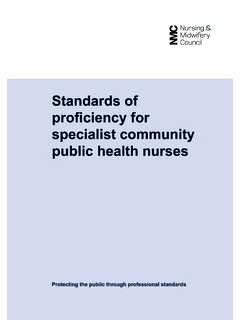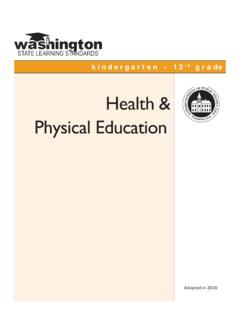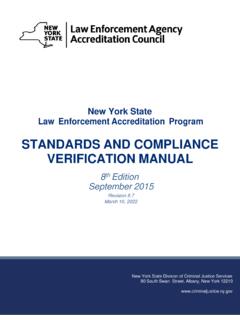Transcription of Competency framework Professional standards for safety and ...
1 Competency framework Professional standards for safety and health at Technical competencies061 health and safety law062 Risk management073 Incident management084 Culture095 Sustainability10 Core competencies116 Strategy117 Planning 128 Leadership and management13 Behavioural competencies149 Stakeholder management1410 Personal performance1411 Communication1512 Working with others1502 TCBTCBC ontents Copyright IOSH 2019 Competency frameworkOne of the major roles that the Institution of Occupational safety and health (IOSH) has to play as a Chartered body is to set the standards for occupational safety and health . As part of this process, we have updated our Competency framework to help OSH professionals build capability and keep pace with rapid change in the practices change constantly, so all Competency frameworks need to be reviewed and refreshed regularly.
2 In addition, as businesses strive to become more sustainable, OSH professionals need to demonstrate a broad range of competencies, to embed good health , safety and wellbeing effectively in workplace cultures. As well as strong technical skills, they need both soft and business skills that equip them to influence and drive change. With 69 competencies, divided into 12 areas across technical, core and behavioural categories, the newly updated framework covers all the skills, knowledge and behaviours needed by occupational safety and health professionals. The framework builds on the foundations of the Competency framework that we developed for Blueprint to offer unrivalled guidance for OSH professionals and employers.
3 It reflects the findings of an extensive research project to ensure alignment with the needs of employers, as well as national and international standards and policies. Uniquely, it also draws on a wealth of data from Blueprint , generated by our self-assessment tool for evaluating capability in occupational safety and health . The release of the updated Competency framework will be followed in 2020 by the launch of an enhanced suite of practical tools, including Blueprint , a new CPD scheme, new technical guides and a free Career Hub for members, with access to thousands of learning resources and career planning framework TechnicalBehaviouralCoreCompetency framework health andsafety law Incident management CultureSustainabilityStrategyPlanning Leadership and management StakeholdermanagementPersonal performanceCommunication Working with others Risk management03 TCBHow we developed the Competency frameworkThe new Competency framework expands on all areas of the previous Competency framework for Blueprint We used primary and secondary data-gathering methodologies in our six-month research research included focus groups and in-depth interviews with employers and a representative sample of IOSH members.
4 Insight from these groups was combined with analysis of 250,000 data sets from over 10,000 Blueprint users in 111 countries. Competency frameworkSecondary research included: -benchmarking with other Professional standards -reviewing corporate Competency frameworks -analysing job descriptions across a wide range of sectors -desktop research referencing a huge spectrum of material: -papers, policies and resources from regulators and institutions around the world -IOSH s own extensive library of OSH research, publications and training programmes. The research led us to conclude that all areas of IOSH s Competency framework needed to evolve, to address the broader scope of OSH and the growing demand for professionals to complement their technical skills with soft and business a result, we have expanded the framework from 27 to 69 competencies, making it the most comprehensive Competency framework for are enormously grateful to all the individuals and organisations who contributed to the research and look forward to seeing how OSH professionals engage with the new framework .
5 0410,000 membersin 111 countriesused Blueprint to assess their development gave us 250,000 data sets to to use the Competency frameworkIOSH s updated Competency framework reflects best practice in occupational safety and health today. It is designed to be an actionable set of standards to help employees and employers maximise performance and minimise risk. EmployeesThe Competency framework provides a set of skills, knowledge and behaviours that can be used by managers and staff to lead and take responsibility for their own learning and development. Each individual s development needs will vary, depending on the role, level, aspirations and sector. The emphasis on specific core or behavioural competencies may differ from one company to the next, due to size, structure or culture.
6 Competency framework05 The framework can be used alongside a wide range of content and courses, from white papers and books to continuing Professional development (CPD). Blueprint , coming next year, will enable personal and objective assessment of a member s competencies, fully linked to a development plan, new CPD and a plethora of other resources to support career development. In the meantime, IOSH members can access free resources and search our current CPD courses, mapped by Competency , via our and recruitersIOSH s Competency framework can improve performance by guiding Professional development and recruitment processes. Technical and core competencies focus on what the employee needs to be able to do, while the behavioural competencies give clear guidance on how an employee should fulfil their a whole, the Competency framework can inform job descriptions, selection processes and learning and development plans.
7 It can also support performance management and help to embed positive behavioural values that add value to employees technical competencies1 | health and safety lawHealth and safety policy development The OSH Professional should be able to develop an OSH policy that is consistent with the business strategy, drivers and culture and that supports productivity and success. The policy must describe the intent of the organisation and its approach to OSH. Accountabilities, responsibilities and arrangements for delivering a safe operation must be described in the policy or associated of health and safety and other legislative frameworks OSH Professional s must be able to interpret and comply with laws and regulations that govern their organisations operations.
8 Laws can sometimes be insufficient to meet the demands of the risk profile, so in such cases OSH professionals must consider the spirit and intent of the law and apply good practice and OSH principles to reduce and safety governance Corporate governance essentially involves balancing the interests of an organisation s many stakeholders, such as shareholders, management, customers, suppliers, financiers, government and the community. It includes assurance mechanisms that routinely check that the organisation s risk profile is accurate, sufficient control is in place and management is effective. Governance includes structures and processes that are designed to ensure accountability, transparency, responsiveness, rule of law, stability, equity and inclusiveness, empowerment and broad-based management systems OSH professionals work collaboratively with stakeholders to build an organisational structure, plan activities, assign responsibilities, develop safe working practices and implement management procedures.
9 The application of a plan-do-check-act framework may be applied. Performance management Performance management requires individuals to deploy appropriate strategies and tools to gather information against performance criteria as part of assessing risks and effectiveness of controls. Individuals must be able to interpret data to evaluate OSH performance, monitor the integrity and effectiveness of controls and evaluate the factors affecting performance and identify areas for improvement. This is to include the identification of both leading and lagging indicators and both output and outcome performance measures to support the articulation of intervention value. The use of technology and the application of systems to support this is and safety auditing This Competency requires the Professional to decide what kind of audit is required, its effective implementation and its use as part of a monitoring strategy.
10 It includes knowing how effectively to design and implement safety tours, gap audits, compliance audits, documentation audits and other inspections of various improvement Continuous improvement requires OSH professionals to develop and embed strategies, methods and/or ways of working to support the continual evolution of OSH working practices, business integration, operational processes, project programmes, efficiency and/or performance. Continuous improvement includes the simplification of control strategies and safety management systems, perhaps in response to changing organisational structure, risk profile and management OSH professionals must establish and deliver an effective quality management process and practice that is deliberately designed to provide consistent results, greater efficiency and effectiveness, with a clear understanding of the inter-related processes needed to deliver organisational and operational section of the framework includes the collection of OSH technical competencies that underpin advisory ability.

